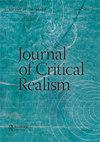Overlapping traditions with divergent implications? Introduction to the special issue on pragmatism and critical realism
IF 2.9
0 PHILOSOPHY
引用次数: 1
Abstract
Intellectual traditions can be seen as complex patchworks of ideas, constructed differently by each observer as they learn about the tradition, and harmonized to an extent through the boundary work done by those interpreters who come to be seen as most authoritative for the tradition concerned (Elder-Vass and Morgan 2022; Elder-Vass 2022; Gieryn 1983). From this perspective, different traditions may sometimes overlap or interleave, and yet also sometimes conflict, with different interpreters forming different understandings of those overlaps and conflicts. This special issue provides ample evidence to support this view of the relationship between critical realism and pragmatism. That the traditions overlap should be no surprise given that leading critical realists have in places drawn, implicitly or explicitly, on the work of leading pragmatists. Roy Bhaskar himself mentions that the people who influenced him – namely the ‘anti-deductivists’, who included his supervisor Rom Harre – were themselves influenced by, amongst others, the founder of pragmatism, Charles Sanders Peirce, although Bhaskar also critiques these influences for their lack of an ontology (Bhaskar 1986, 3). Bridget Ritz’s recent paper on abduction and retroduction in the two traditions seems to suggest that these concepts, for example, came to critical realism from Peirce, and critical realists have then developed their own variation of the concept of retroduction (Ritz 2020) (also see Danermark, Ekström, and Karlsson 2019, 109–122). Margaret Archer draws more explicitly on George Herbert Mead’s work on the internal conversation in her influential work on reflexivity (Archer 2003). We also find intriguing parallels between the traditions even in cases where lines of influence are invisible and perhaps unlikely. Roy Bhaskar’s understanding of language and its relation to the world is remarkably similar to the work of Charles Peirce though it is unclear whether he was directly influenced by Peirce’s work (Nellhaus 1998). They are certainly close enough for Kieran Cashell to argue recently that we need a synthesis of Peirce and Bhaskar’s work on representation (Cashell 2009). Stephen Pratten provides another example in this issue in his comparison of Tony Lawson and his Cambridge group’s social positioning theory with the neglected work of John Dewey on the concept of the offices that people and things may occupy (Pratten 2022). Even in the absence of lines of influence, parallel theory developments like this suggest some similarity in the broad philosophical orientations of pragmatism and critical realism, and some potential for these traditions learning more from each other. Jamie Morgan, for example, has suggested that critical realists would find value in the work of the leading contemporary pragmatist Nicholas Rescher (Morgan 2019). Further evidence of affinity is provided by scholars who have passed through both traditions and indeed often continue to find both useful for their work (see, for example, Vandenberghe 2014). This, indeed, is one of the unexpected themes to emerge from our roundtable discussion in this issue (Barman, Porpora, and Carrigan 2022). Although we expected this to take the form of a debate between contrasting views, our contributors Emily Barman and具有不同含义的重叠传统?实用主义与批判现实主义特刊简介
知识传统可以被视为思想的复杂拼凑,由每个观察者在了解传统时不同地构建,并通过那些被视为有关传统最权威的诠释者所做的边界工作在一定程度上协调一致(Elder-Vass和Morgan 2022;Elder-Vass 2022;Gieryn 1983)。从这个角度来看,不同的传统有时会重叠或交错,但有时也会冲突,不同的解释者对这些重叠和冲突形成不同的理解。这期特刊提供了充分的证据来支持批判现实主义与实用主义之间关系的观点。鉴于领先的批判现实主义者在某些地方或隐或明地借鉴了领先的实用主义者的工作,这两种传统的重叠应该不足为奇。Roy Bhaskar自己提到,影响他的人——即“反演绎主义者”,包括他的导师Rom Harre——他们自己也受到实用主义创始人Charles Sanders Peirce的影响,尽管Bhaskar也批评这些影响缺乏本体论(Bhaskar 1986, 3)。Bridget Ritz最近关于两种传统中的溯因和还原的论文似乎表明,这些概念,例如,从皮尔斯那里来到批判现实主义,批判现实主义者随后发展了他们自己的还原概念变体(Ritz 2020)(也见Danermark, Ekström, and Karlsson 2019, 109-122)。玛格丽特·阿彻在她关于反思性的有影响力的著作中更明确地借鉴了乔治·赫伯特·米德关于内部对话的研究(阿彻2003)。我们还发现了传统之间有趣的相似之处,即使是在影响线不可见或不太可能的情况下。Roy Bhaskar对语言及其与世界的关系的理解与Charles Peirce的作品非常相似,尽管尚不清楚他是否直接受到了Peirce作品的影响(Nellhaus 1998)。他们当然足够接近,以至于Kieran Cashell最近提出,我们需要综合Peirce和Bhaskar在表征方面的工作(Cashell 2009)。Stephen Pratten在这个问题上提供了另一个例子,他将Tony Lawson及其剑桥小组的社会定位理论与John Dewey关于人和事物可能占据的办公室概念的被忽视的工作进行了比较(Pratten 2022)。即使在没有影响的情况下,类似这样的平行理论发展表明,实用主义和批判现实主义的广泛哲学取向有一些相似之处,这些传统有可能相互学习。例如,杰米·摩根(Jamie Morgan)认为,批判现实主义者会在当代实用主义领袖尼古拉斯·雷舍尔(Nicholas Rescher)的作品中找到价值(Morgan 2019)。通过这两种传统的学者提供了进一步的亲和力证据,并且确实经常继续发现这两种传统对他们的工作都很有用(例如,参见Vandenberghe 2014)。事实上,这是我们在这个问题上的圆桌讨论中出现的意想不到的主题之一(Barman, Porpora, and Carrigan 2022)。尽管我们本以为这是一场不同观点之间的辩论,但我们的撰稿人艾米丽·巴曼和
本文章由计算机程序翻译,如有差异,请以英文原文为准。
求助全文
约1分钟内获得全文
求助全文

 求助内容:
求助内容: 应助结果提醒方式:
应助结果提醒方式:


